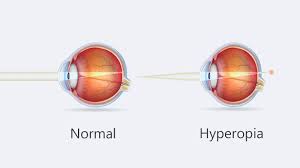Conditions and disorder
Conditions and disorder
Refractive Errors
Refractive errors are the most common types of vision problems. They happen when the cornea and the natural lens of the eye are not able to focus the light accurately on the retina. The most common causes of refractive errors are the length of the eyeball (longer or shorter), changes in the shape of the cornea, or aging of the natural lens. The prevalent symptom of refractive errors is blurred vision.
Four common refractive errors include myopia (nearsightedness), hyperopia (farsightedness), presbyopia, and astigmatism.
Myopia (nearsightedness)
In this eye disorder the length of the eyeball is longer than usual which results in blurry distance vision. It is usually an inherited disease.
Hyperopia (farsightedness)
In this eye disorder the length of the eyeball is shorter than usual which results in blurry near vision. In advanced hyperopia, vision can be blurred at all distances.
Astigmatism
In this eye disorder the wrong shape of the cornea results in distorted vision.
Refractive errors can be corrected with eyeglasses, contact lenses, or laser refractive surgeries based on the diagnosis of an eye care professional.
Presbyopia
In this eye disorder the aging of the natural lens of the eye results in dim near vision and difficult reading. It normally starts after age 40.
Cataract
Cataracts occur when proteins in the eye form a dense and cloudy area in the natural lens of the eye. The foggy lens of the eye can not pass through and focus the light on the retina so it may lead to myopia or sometimes hyperopia.
A cataract develops slowly and eventually disturbs the eyesight. It can affect one or both eyes. Some common symptoms may include cloudy, blurry, or double vision, impaired night vision, faded colors, and halos around light.
Cataracts mostly occur due to aging, however, there are other risk factors including trauma, radiation, genetics, previous eye surgery, smoking, obesity, and so on. The only effective treatment for cataracts is surgery.
Glaucoma
Glaucoma is a condition in which high intraocular pressure damages the optic nerve of the eye which results in vision loss. Aqueous humor or the fluid in the eye should drain out of the eye through a channel namely trabecular meshwork which is at the angle where the iris and the cornea meet. If the aqueous humor can not flow out of the eye, whether the drainage system is blocked or the fluid is overproduced, it might lead to an increment in the intraocular pressure. Glaucoma usually runs in the family and mostly has no early signs or even pain.
Some types of glaucoma are open-angle glaucoma and closed-angle glaucoma, secondary glaucoma, normal-tension glaucoma, and pigmentary glaucoma. Open-angle glaucoma is the most common type of glaucoma in which the drainage system looks well but the fluid does not flow out properly. It may lead to decreased peripheral or central vision, tunnel vision, and finally blindness if it is not treated. Closed-angle glaucoma is more common in Asia. In this type of glaucoma, the drainage system does not work well since the angle becomes too narrow. It may lead to nearsightedness and cataracts. Secondary glaucoma is a less common type of glaucoma in which other conditions, like cataracts or diabetes, increase the intraocular pressure. Normal-tension glaucoma is also a less common type of glaucoma in which the intraocular pressure is within the normal range however the optic nerve is damaged for unknown reasons. Pigmentary glaucoma is a less common type of glaucoma in which the tiny bits of pigments of the iris block the drainage canals.
Keratoconus
Normally the healthy cornea has a round and dome shape like a ball and a strong structure due to tiny fibers of proteins namely collagen. These fibers may get weak and can not hold the shape of the cornea, thus it gets more cone-like and thin which may result in blurry vision, double vision, nearsightedness, and/or irregular astigmatism. While the main cause of keratoconus is unknown, some risk factors might raise its occurrence including genetics, environment, age, and some diseases.
The early symptoms of keratoconus are minor blurring or distortion of vision. Other symptoms include poor night vision, sensitivity to bright light, eye strain, halos around lights, and so on.
Pterygium
A pterygium is also known as a surfer’s eye is a growth of pinkish, fleshy triangular tissue on the conjunctiva (the clear tissue that lines your eyelids and covers your eyeball) which may extend onto the cornea. It may grow slowly and stop after a while, rarely in extreme cases it may cover the pupil and affect the vision.
There are some causes that may most likely lead to this condition including ultraviolet light, dust, and wind. The symptoms of pterygium can range from mild to severe and some of them include redness, blurry vision, eye irritation, feeling foreign object in your eye, and dry and itchy eye.
Blepharitis
Blepharitis is the inflammation of oil glands in the eyelids which may lead to dry eye. Blepharitis can be caused by a type of bacteria, blocked oil gland, allergies, infection with a virus, or some skin conditions. It is not a contagious disease and does not harm your eyesight permanently. Some of the common symptoms of blepharitis are watery eyes, red eyes, greasy eyelids, itchy eyelids, red, swollen eyelids, flaking of the skin around the eyes, crusty eyelashes, eyelid sticking, more frequent blinking, sensitivity to light, and blurred vision that usually improves with blinking.

















